
Maria Feodorovna, known before her marriage as Princess Dagmar of Denmark, was Empress of Russia from 1881 to 1894 as spouse of Emperor Alexander III. She was the daughter of Christian IX of Denmark and Louise of Hesse-Kassel. Maria's eldest son became the last Russian monarch, Emperor Nicholas II. Maria lived for 10 years after Bolshevik functionaries killed Nicholas and his immediate family in 1918.

Alexandra Feodorovna, Princess Alix of Hesse and by Rhine at birth, was the Empress of Russia as the consort of Emperor Nicholas II from their marriage on 26 November [O.S. 14 November] 1894 until his forced abdication on 15 March [O.S. 2 March] 1917. She was the last empress consort of Russia. A favourite granddaughter of Queen Victoria of the United Kingdom, she was, like her grandmother, one of the most famous royal carriers of haemophilia and bore a haemophiliac heir, Alexei Nikolaevich, Tsarevich of Russia. Her reputation for encouraging her husband's resistance to the surrender of autocratic authority and her known faith in the Russian mystic Grigori Rasputin severely damaged her popularity and that of the Romanov monarchy in its final years. She and her immediate family were all killed while in Bolshevik captivity in 1918, during the Russian Revolution. In 2000 the Russian Orthodox Church canonized her as Saint Alexandra the Passion Bearer.

The Catherine Palace is a Rococo palace in Tsarskoye Selo (Pushkin), 30 km south of St. Petersburg, Russia. It was the summer residence of the Russian tsars. The Palace is part of the World Heritage Site Saint Petersburg and Related Groups of Monuments.

Alexander Palace is a former imperial residence near the town of Tsarskoye Selo in Russia, on a plateau about 30 miles (48 km) south of Saint Petersburg. The Palace was commissioned by Empress/Tsarina Catherine II in 1792.

The Summer Palace is either of the two wooden Baroque palaces built by Francesco Bartolomeo Rastrelli on Tsaritsa's Meadow behind the Summer Garden in St. Petersburg. Neither building survives.

The Imperial Crown of Russia, also known as the Great Imperial Crown, was used by the monarchs of Russia from 1762 until the Russian monarchy's abolition in 1917. The Great Imperial Crown was first used in a coronation by Catherine the Great, and it was last worn at the coronation of Nicholas II. It was displayed prominently next to Nicholas II on a cushion at the State Opening of the Russian Duma inside the Winter Palace in St. Petersburg in 1906. It survived the 1917 revolution and is currently on display in Moscow at the Kremlin Armoury's State Diamond Fund.
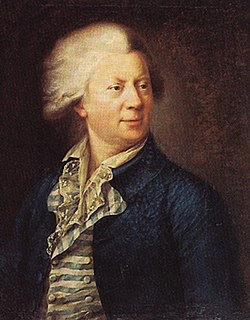
Yury Matveyevich Felten (1730–1801) was a court architect to Catherine the Great, Empress of Russia.

Pavlovsk Palace is an 18th-century Russian Imperial residence built by the order of Catherine the Great for her son Grand Duke Paul, in Pavlovsk, within Saint Petersburg. After his death, it became the home of his widow, Maria Feodorovna. The palace and the large English garden surrounding it are now a Russian state museum and public park.

Grand Duchess Maria Nikolaievna of Russia was a daughter of Emperor Nicholas I of Russia, and sister of Alexander II. In 1839 she married Maximilian, Duke of Leuchtenberg. She was an art collector and President of the Imperial Academy of Arts in Saint Petersburg.
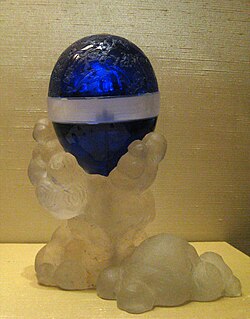
The Constellation egg is one of two Easter eggs designed under the supervision of Peter Carl Fabergé in 1917, for the last Tsar of Russia, Nicholas II as an Easter gift to his wife, the Tsarina Alexandra Feodorovna. It was the last Imperial Fabergé egg designed. It remains unfinished.
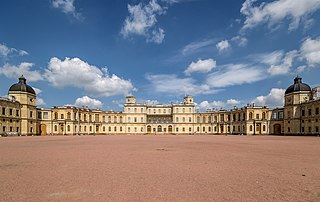
The Great Gatchina Palace is a palace in Gatchina, Leningrad Oblast, Russia. It was built from 1766 to 1781 by Antonio Rinaldi for Count Grigori Grigoryevich Orlov, who was a favourite of Catherine the Great, in Gatchina, a suburb of the royal capital Saint Petersburg. The Gatchina Palace combines classical architecture and themes of a medieval castle with ornate interiors typical of Russian classicism, located on a hill in central Gatchina next to Lake Serebryany. The Gatchina Palace became one of the favourite residences of the Russian Imperial Family, and during the 19th century was an important site of Russian politics. Since the February Revolution in 1917 it has been a museum and public park, and received UNESCO World Heritage Site status in 1990.

The Winter Palace is a palace in Saint Petersburg that served as the official residence of the Russian Emperor from 1732 to 1917. The palace and its precincts now house the Hermitage Museum. Situated between Palace Embankment and Palace Square, adjacent to the site of Peter the Great's original Winter Palace, the present and fourth Winter Palace was built and altered almost continuously between the late 1730s and 1837, when it was severely damaged by fire and immediately rebuilt. The storming of the palace in 1917, as depicted in Soviet art and in Sergei Eisenstein's 1928 film October, became an iconic symbol of the Russian Revolution.

The principal or Jordan Staircase of the Winter Palace, St Petersburg is so called because on the Feast of the Epiphany the Tsar descended this imperial staircase in state for the ceremony of the "Blessing of the Waters" of the Neva River, a celebration of Christ's baptism in the Jordan River. The staircase is one of the few parts of the palace retaining the original 18th-century style. The massive grey granite columns, however, were added in the mid 19th century.

St George's Hall is one of the largest state rooms in the Winter Palace, St Petersburg. It is located on the eastern side of the palace, and connected to The Hermitage by the smaller Apollo Room.
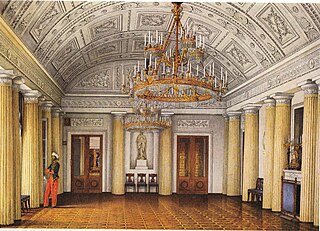
The Arabian Hall, sometimes known as the Blackamoor Hall or the Arabian Dining Room, is one of the private rooms of the Winter Palace in Saint Petersburg. In the Tsarist era, it was the room from which imperial processions through the state rooms began. The double doors were designed to be on a straight axis through the principal state rooms and ultimately the Jordan Staircase, forming an enfilade. Thus it was here the Romanov family often assembled, in private, before state receptions and occasions. The privacy of the room was not compromised by the small private courtyard from which windows, which once led to the Tsaritsa's winter-garden below, admitted light.

The Neva Enfilade of the Winter Palace, St Petersburg, is a series of three large halls arranged in an enfilade along the palace's massive facade facing the River Neva.

Coronations in Russia involved a highly developed religious ceremony in which the Emperor of Russia was crowned and invested with regalia, then anointed with chrism and formally blessed by the church to commence his reign. Although rulers of Muscovy had been crowned prior to the reign of Ivan III, their coronation rituals assumed overt Byzantine overtones as the result of the influence of Ivan's wife Sophia Paleologue, and the imperial ambitions of his grandson, Ivan IV. The modern coronation, introducing "Western European-style" elements, replaced the previous "crowning" ceremony and was first used for Catherine I in 1724. Since tsarist Russia claimed to be the "Third Rome" and the replacement of Byzantium as the true Christian state, the Russian rite was designed to link its rulers and prerogatives to those of the so-called "Second Rome" (Constantinople).
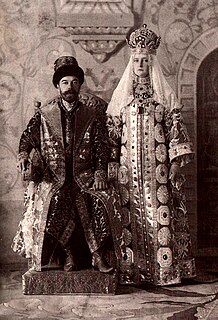
The 1903 ball in the Winter Palace was a luxurious ball during the reign of the Emperor Nicholas II of Russia. It was held in the Winter Palace, Saint Petersburg, in two stages, on February 11 and 13. All the visitors were in bejeweled 17th-century style costumes, made from designs by the artist Sergey Solomko, in collaboration with historical experts.

The Private Apartments of the Winter Palace are sited on the piano nobile of the western wing of the former imperial palace, the Winter Palace in St Petersburg. Access to the private rooms, for members of the Imperial Family, from the exterior was usually through the Saltykov Entrance which was reserved for use by only the Tsar, Tsaritsa and grand dukes and grand duchesses. A second access was through a discrete box-like porch, on the western end of the Palace's Neva façade. From the ground floor, it can be accessed from the October Staircase, formerly known as His Majesty's Own Staircase; this double-flighted imperial staircase was a secondary entrance to the private apartments, and provided a more convenient route to the palace's ground floor and private entrances than the more formal and ceremonial public route through the state apartments. During the October Revolution of 1917, this was the entrance by which the revolutionaries gained access to the palace in order to arrest the Provisional Government in the small private dining room. Since that date it has been known as the October Staircase and has a plaque commemorating the event. Despite its size and grandeur, the October Staircase was a secondary staircase, the Jordan Staircase being the principal.

The Pavlovsk Park is the park surrounding the Pavlovsk Palace, an 18th-century Russian Imperial residence built by Tsar Paul I of Russia near Saint Petersburg. After his death, it became the home of his widow, Maria Feodorovna. It is now a state museum and a public park.

























